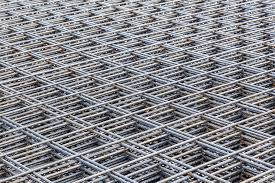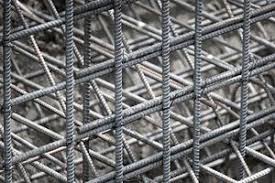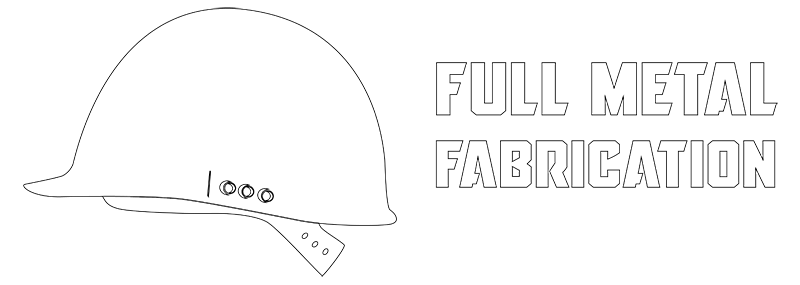Welded Wire Mesh vs Rebar for Concrete Reinforcement


I have googled the subject of wire mesh vs rebar and found there to be very few legitimate resources on this subject. So given Full Metal Fabrication's experience in both rebar fabrication and concrete contracting, I feel we could put our 2 cents in on the topic. If you are in a hurry and want me to hit you answer first, the reality is they both have a time and place in construction. I would recommend wire mesh for all 4" thick concrete slabs that typically only saw loads from pedestrian foot traffic or small vehicular traffic (e.g. driveway). I would use a rebar grid for foundations (piers and footings), as well as slabs that experience larger vehicular loads or industrial use when it would be an absolute disaster trying to repair a slab (e.g. an industrial freezer or a plant with complex piping).
Before we jump into the details of the pros and cons of each reinforcement method, first a bit of history on the two. Sorry America, you didn't invent the use of reinforced concrete. Brace yourself. The French did. In 1853, Joseph Monier first used rebar to simply keep his structure together and not for its tensile strength benefits. The Germans and British then improved upon the design and eventually the Americans took it to the next level, literally, building the first skyscraper. Skyscrapers...now that's American.
Welded Wire Mesh (WWM) or Fabric (WWF) first came about in the early 1900's and was used in road construction. In 1922, the state of Illinois issued a test of 78 different road designs. WWM performed best and was used in thousands of miles of road construction.
Why is history so important in this debate? Well, if you notice my opinion falls in line with the function it served early in it's construction life. I don't see that as a coincidence. In construction today, you have a lot of biased opinions from suppliers, engineers, and even contractors. Below are some pros and cons that I have experienced and what I like to believe as unbiased.
Rebar provides a large amount of tensile strength to concrete, which is weak in tension (but is strong in compression), which is often why engineers prefer it in foundations and slabs with large loads and high frequency. The ACI (American Concrete Institute) 330R for paving code matches this opinion. If you do a Finite Element Analysis (FEA) on a building foundation you will see the bulk of the structural load in the footings and piers, while the interior slab sees very little. Therefore, unless you have forklifts or semi-truck deliveries or other large live loads on the interior slab, I would leave the rebar out as it'll just add time and cost to your project. Location of the rebar does need to be fairly accurate to the design in order to get the required strength. An inch this way or that way is no big deal. But if it hits the dirt in the side of the footing or pier you are looking at corrosion issues as well as a potential inadequate strength of the design. Overall, I would consider the ability to keep the rebar in place during the pour a big plus for rebar compared to WWM. If you put it in the right place during concrete prep, it's likely going to stay there due to rebar chairs, tie wire, and good ole inertia. The majority of rebar's downside is that it carries a drastically higher material and installation cost than WWM.
WWM is a very versatile product and in my opinion is underutilized in residential and small commercial projects as people are replacing it with concrete additives such as steel or poly fibers. The advantage of WWM is its ease of installation and standard manufactured grid design. It also does an incredible job of keeping concrete together when cracks do happen. It prevents water from getting into the crack and under the slab as well as keeping the elevation consistent between both sides of the crack. Most people ignore the fact that you can also get different gauge WWM. It does make it more difficult to install but I'd install extra heavy gauge WWM over a rebar grid any day of the week. The disadvantage is that it is difficult to keep the WWM off the ground while pouring. They do make chairs for it, but the sheets sag and it still makes it difficult to keep per the design requirements. However, contrary to popular belief, WWM that is left on the ground while pouring, while not ideal, DOES actually still add value to the structure. If you have ever tore out sidewalk that had WWM installed, you know exactly what I mean. It still helps prevent the shift of slabs after a crack.
The last topic I'd like to touch on is cracks. What an interesting and misunderstood topic. So many people ask "which is more likely to reduce cracking?". Sigh. What a difficult and wrong question to ask. You really need to understand what causes cracking before you can answer that. Cracking can occur from over loading, thermal expansion, plastic shrinking during pouring, and a host of external forces from tree roots, ice heaving, etc. In a short answer, if you are looking to prevent cracking, I would encourage you to do a more comprehensive plan that included ensuring a well compacted base, pour at a cool time of day with little wind, saw correctly placed control joints at the proper time, AND have an adequate reinforcement deign that is properly placed in the field, which could be rebar or WWM.

Interesting stuff!
It’s good to know that welded wire mesh can keep concrete together and prevent further damage if there is ever a crack. I have been thinking about having a patio put in my back garden sometime before spring rolls around. WWM sounds like a good reinforcer for this type of project.
I thought it was interesting when you explained that placing rebar grids are used in foundations. I would say that it would probably be best to hire a concrete contractor if you are trying to layout rebar yourself. It would be important to work with someone that understands how to make a structure strong and reliable.
What is the proper way to refer to this reinforcing?
WWM – Welded Wire Mesh
WWF – Welded Wire Fabric (I have been using this term for over 30 years)
WWR – Welded Wire Reinforcing
Thank you.
Hi Jeffrey,
I checked with our wire products manufacturer and their standard pricing sheet shows “Welded Wire Fabric for Concrete Reinforcement”. That being said, colloquially, they are all acceptable. I’ve seen all on engineered foundation drawings.
Hi Henry,
I see from the photos attached to your article that the wire making up the fabric is deformed, presumably indented. It wasn’t always so in Europe and cold drawn plain wires were the norm for many years. Is all mesh produced nowadays made from deformed wire, and if so, any idea when deformed wires became the norm in North America?
Thanks
John
Hi John,
Thanks for the comment and you are right in that some wire is deformed and some is plain or “slick”, which can be determined by the designation “D” for deformed and “W” for standard plain wire. In regards to wire today, I’ve seen both plain and deformed still in use. However, I’ve seen more plain wire in rolls and standard 10 gauge sheets and more deformed wire for heavier gauge sheets, 8 gauge and thicker.
Thank you for the article.
Q. What do you consider as a “larger vehicular loads”, such as a Class A RV or full coach vehicle at 13,000 to 30,000lbs? We are paving about a 4″ depth driveway and the developer, in southern coastal Oregon [rain country], would like go with WWM etc. It is a long and wide driveway. The base is fairly solid and well done.
Respectfully,
Hi Dave, great question. Answer first: I feel comfortable with the standard gauge WWM, but the only concern would be the 4″, which is depending on your soil bearing pressure and compaction (which I have no way of knowing). A more detailed answer would be to refer you to the American Concrete Institute (ACI) 330r – 08 guide for concrete paving. I can send you the original document as well as a presentation that summarizes it. You’ll see in the summary that the reinforcement should be just fine as most of the forces the pavement will see is compression, not tension (assuming sub grade has a high bearing pressure which results in low deflection of the slab). If it were me, and I wanted more insurance for longevity and durability, I’d consider adding an inch or 2 of thickness to the slab, which unfortunately is costly.